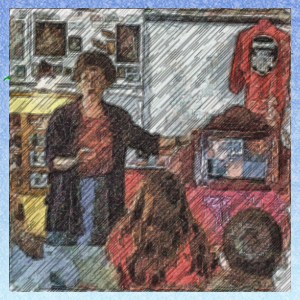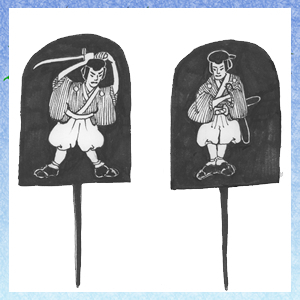School Residency Programs
School Residency Programs in Picture-Storytelling (Etoki) Traditions from Japan
Japan has a long tradition of e-toki (Picture-Storytelling), which has taken many forms over the centuries, and these workshops involve students in developing and performing their own original stories. These programs are designed for classrooms and can be customized for any grade. A school day includes four classes per day. These workshops may be adapted for any age group and can run anywhere from 3-10 sessions.

1) Kamishibai—Kamishibai (paper theater) is a form of Japanese performance art that combines the illustrated storyboards, with oral storytelling. The stereotypical image of the kamishibai street performer in Japan during the 1930s and 40s is of a candy peddler on a bicycle, traveling from neighborhood to neighborhood to sell hand-made sweets and mesmerize children with riveting cliffhangers, which he would narrate orally while manipulating a series of illustrated cards within a wooden stage. These storytellers became so popular that by the 1950s when TV first came to Japan, it was called “ denki (electric) kamishibai.” Kamishibai has almost died out as a street-performance art in Japan, but now more and more people are making their own hand-made ( tezukuri) kamishibai and performing them at annual festivals. Tezukuri kamishibai is what we will be making and performing in weekly workshops.

2) Tachi-e (Standing-Pictures)—Tachi-e (standing-pictures) was actually the first “kamishibai” because it was theater (shibai) performed with paper (kami) puppets. Tachi-e was invented in Japan during the 1800s and was a popular form of street-performance art before the emergence of the “flat pictures” (hira-e) or story cards that are more commonly associated with kamishibai today. These fascinating flip puppets are performed against a black curtain so that the edges of the paper disappear and the movement of the character stands out. Since these puppets are especially suited to transformations, ghost stories were particularly popular, but they can be adapted to all kinds of genres.

3) Emaki (Picture Scrolls)—Picture scrolls came to Japan from China, but the Japanese tended to create narratives that could be told orally as the storyteller unravels the long strip of paper, revealing the sequence of events as the story unfolds.

4) From Kamishibai to Modern Manga and Animé—Kamishibai is widely hailed as a precursor of manga and anime, and in this workshop, we will examine the visual style and techniques of both street-performance kamishibai and modern manga and animé to understand how the more recent forms of visual storytelling, which have become so popular world-wide, evolved.


